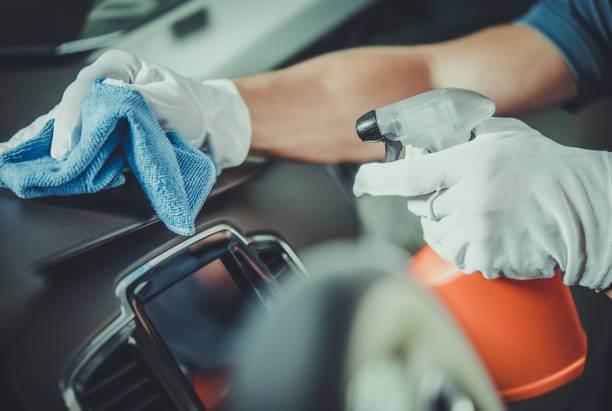The Best Professional Car Interior Cleaning Products to Shop

As you might expect, the most crucial products in the entire realm of detailing are cleaners and the chemicals they contain. In addition to removing filth and other pollution, the many delicate surfaces you find on vehicles require what they do, which is essential. Car interior cleaning products enable the removal of any potentially dangerous particles without irritating or harming the surface underneath.
You have a wide variety of potent car interior cleaning products formulated to address specific issues and are suitable for any vehicle surface, inside and out. What is the science underlying how these automobile accessories function, though? Well, let the professionals explain.
Solvents, Abrasives, And Detergents
When cleaning cars, it’s critical that a recipe be able to chemically dissolve and encapsulate grease or filth. This is because it enables the safe removal of the substance by wiping or washing.
Most car interior cleaning products are water-based detergent formulas containing unique surfactants that handle these processes. The experts will discuss these cars detailing online products in more detail shortly. However, it’s essential to understand that water-based agents are not the only car interior cleaning products you use.
Read also:- 1.0ct Round Brilliant Halo 4 Prong Moissanite Solitaire Engagement Ring
Solvents
You can achieve dissolving sticky residues chemically into a solute or component dispersed in a solution using solid solvent-based products. It usually only takes a quick wipe with your car-cleaning microfiber cloth to eliminate this portion of the sticky contaminants and used solvent.
The crucial point in this situation is that you can employ only a partial number of non-oils, solvent-resistant surfaces with solvents without suffering damage. These are very effective on glass and painting, although they can dissolve into the existing characters.
They will undoubtedly be clean. However, not in the manner one would anticipate seeing on an automobile. Solvent-based products thus come with the purpose of specialized use instead of blanket application to an entire vehicle.
It’s also interesting to note that all-purpose car interior cleaning products and heavy degreasers, while not classified as solvent-based, contain a relatively small amount of solvent to remove organic and oil-based stains.
Abrasive Cleaners
Similar to this, abrasive cleaners come for specialized usage on particular “polishable” surfaces. Abrasive cleaners typically work through motorized action, whereas car interior cleaning products remove contaminants and oxidation at the molecular level, frequently together with a thin surface layer.
Again, you cannot categorize these as suitable for various surfaces; You wouldn’t clean your carpet or leather furniture with a metal polish, would you?
Agitation
Additionally, you must not confuse product agitation with mechanical cleaning. Even on a very tiny scale, there is undoubtedly some mechanical scouring going on here to assist in the release of dirt. However, this is more about agitating the cleaning than mechanical activity.
In many respects, it involves repositioning the solution so that it contacts every surface and crevice, and, most critically, it involves refreshing the solution. You achieve it by treating any remaining dirt with the new key as you throw out the old solution.
Except for good pre-wash car interior cleaning products, which are first-stage treatments primarily suited to removing the dirtiest build-up without contact, you can make many cleansers more effective by light agitation with a brush or cloth.
Detergent Cleaners That Use Water
The experts categorize a detergent as a car interior cleaning product that removes oil and filth. Examples of detergents include soap and shampoo. However, what exactly causes any detergent to function? What, more specifically, makes these kinds of cleaning agents suitable for use on automobiles? Mainly when you must take different surface materials into account.
Surfactants
Surfactants come in a few distinct varieties, and they excel at removing various sorts of soiling. Compared to high-foaming anionic surfactants, low-foaming non-ionic surfactants may be more effective at emulsifying oils into solutions. They are lovely for lifting and encapsulating particulate soils.
You may ideally use surfactants to alter the physical properties of water. For maximum effectiveness, any cleaning agent must be able to permeate the surface and distribute within, as in the case of fabrics.
In normal conditions, water has a high surface tension that causes it to form beads and prevents it from spreading or penetrating quickly. Surfactants work to lower this surface tension so that water can better-wet surfaces, squeeze into tighter spaces, and remove contaminants much more effectively than water alone.
Emulsifiers
As the experts noted, some car interior cleaning products are particularly effective at emulsifying oils. This is crucial when cleaning clothes, automobiles, and other surfaces that become soiled with grease. These are important since water and oils don’t often combine. Therefore, they reduce the size of the giant, fatty molecules so that the solution can remove them.
Endnote
You may learn more about car interior cleaning products at Carorbis.
Also, Read This: Innovative Car Interior Decor Ideas You Must Consider



